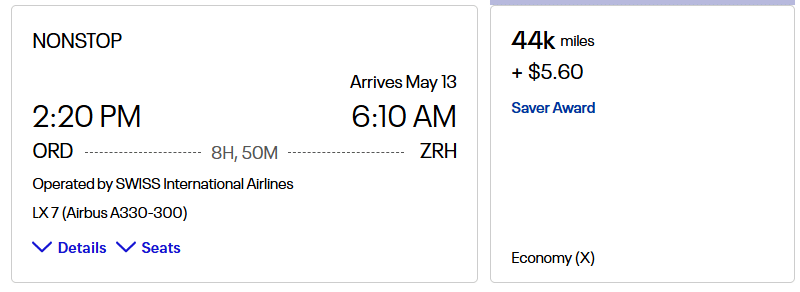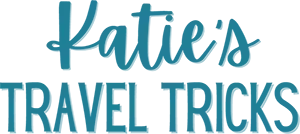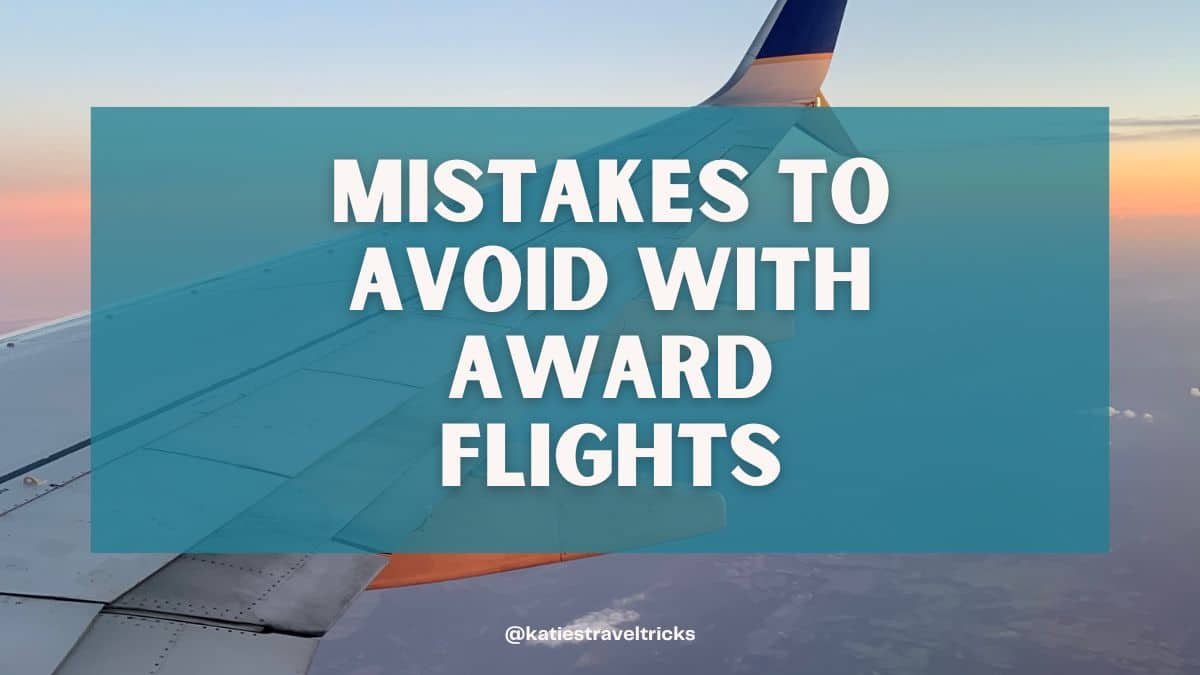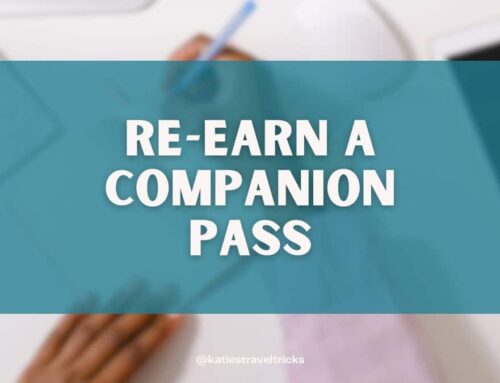All content was accurate at the time of publication. Check issuer’s site for most up to date information.
Katiestraveltricks.com site has partnered with CardRatings for our coverage of credit card products. Katiestraveltricks.com and CardRatings may receive a commission from card issuers. This compensation may impact how and where links appear on this site. This site does not include all financial companies or all available financial offers. Terms apply to American Express benefits and offers. Enrollment may be required for select American Express benefits and offers. Visit americanexpress.com to learn more. For Capital One products listed on this page, some of the above benefits are provided by Visa® or Mastercard® and may vary by product. See the respective Guide to Benefits for details, as terms and exclusions apply.
Booking Flights with Points: Mistakes to Avoid
Booking flights with points can feel like navigating a maze. With so many airlines, routes, and ever-changing award pricing, it’s easy to get lost. But fear not! This guide breaks down common mistakes when booking award flights and provides tips to help you maximize your points and fly smarter.
We’ll uncover the most common mistakes people make when redeeming their points and learn what to do instead. I’ll also give you some tools and resources to help you get the most out of your points based on what you value.
Airline Alliances
Before we dive deeper into booking with points, it’s crucial to understand the concept of airline alliances. These are essentially partnerships between airlines across the globe. I cover both of these in depth in my free course in lessons 42-50. I also have a free guide to transfer partners, which you can download. The most important overall concepts you need to understand are:
-
- Airlines operate in partnerships with other airlines. These partnerships allow you to use your miles from one airline to book on another — but only when airlines open seats to their partners.
-
- Flexible points credit cards (like Chase Sapphire Preferred® Card or Capital One Venture X Rewards Credit Card) allow you to transfer your points and miles to a variety of airlines.
Common Mistakes and How to Avoid Them
Not Comparing Points to Cash Prices
One of the biggest mistakes I see people make is not comparing the points needed for a transfer to the cash price of a ticket. It’s so tempting to jump right into transferring your points to an airline partner, but don’t rush to do that! Sometimes, using your points to book a ticket directly through a travel portal like Chase TravelSM can actually be a better deal. It can often use fewer points and be way less of a headache than hunting for award availability.
When you have a trip in mind, start tracking those ticket prices on Google Flights. Even just doing occasional searches will give you a good sense of what flights to your destination cost. This gives you a benchmark so you can compare apples to apples (or points to dollars!) and figure out the absolute best way to book your flight using the fewest possible points.
Not Considering Taxes and Fees
Okay, let’s talk about something that can really throw a wrench in your award travel plans: taxes and fees! This is a mistake I see all the time. Unless you’re booking through a travel portal like Chase TravelSM, your points only cover the cost of your ticket, not the taxes and fees. That means you’ll have to pay those separately, and in the vast majority of cases, that will be with cash.
Within the US, it’s usually not a big deal – we’re talking around $5.60 each way. But internationally? That’s where things can get tricky. Some airlines not only add the mandatory taxes but also slap on fuel surcharges or other random fees, and these can really add up. For example, I’ve seen situations where Emirates, which is known for its fancy planes, had around $300 in taxes on a one-way award ticket! On the other hand, I’ve seen airlines, like United, with fees as low as $7.
Now, there’s no right or wrong answer here. Maybe you really want to fly Emirates and you don’t mind paying the extra $300 for the experience. That’s totally fine! But you have to compare.
That’s why I’m such a fan of PointsYeah.com – it shows you the price in points and the taxes and fees, which not all search tools do. This also ties into comparing to the cash price because the cash price already includes those taxes and fees.
I’m not saying you should never pay taxes and fees on an award ticket. Sometimes, it’s totally worth it for a better route or a better flying experience. But here’s the bottom line: if you’re going through the trouble of transferring points to book a flight, it should be doing one of three things: saving you points, giving you a better route, or giving you a better flight experience. Otherwise, what’s the point?
Not Checking Pricing with Alliance Partners
If you want to fly a specific airline or route, the best deal is not always going to be booking directly with that airline. In fact, you’ll often get a better deal by booking the flight through an alliance partner. Different airlines charge different prices for the same exact flight.
You can sometimes save a lot of miles (or taxes and fees) by booking with an alliance partner. For example, here’s a flight on May 12, from Chicago to Zurich flying non-stop on Swiss Airlines. You can book this flight with United Airlines for 44k miles and $5.60. OR you can book the same exact flight with Air Canada for 40k miles and $81 (Canadian dollars). 

Now, if you only have miles with one airline, this strategy won’t help you. But if you have transferable points, it’s worth checking the pricing with a few of the alliance partners to see which one offers the best deal before transferring points and booking the flight.
Not Putting in the Correct Number of Passengers When You Search
When running award searches, you might start by searching for just one person. There’s nothing wrong with starting a search this way. It can give you an idea of general pricing and routing options. But- when you’re getting ready to book, it’s essential to search for the correct number of passengers!
This is because airlines only release a certain number of award seats. For airlines that use dynamic pricing, they only have a set number of tickets at certain prices. For example, you might see that the flight you want costs 12,000 points per person when searching for one passenger. But it could be that there is only one seat left at that 12,000 point price. When you go to add all the other passengers, the price might be significantly higher.
Transferring Points Before You Confirm Availability
It’s important to confirm availability with the airline before you transfer any points to book a flight. That’s because once you transfer points to an airline, they can’t be transferred bank to your bank. They’re stuck with that airline until you use them.
Let’s say you run a search on a site like Pointsyeah.com. Your dream flight is available for a reasonable price. Yay! You’ve made sure to include the correct number of passengers, and Pointsyeah shows availability for all of you to book through Air Canada Aeroplan. You rush to transfer your points, then head to Aeroplan.com to book. Only when you get to the Aeroplan website, you can’t see the same availability that Pointsyeah was showing.
Tools like Pointsyeah and Seats.aero are a great place to start when searching for award availabilty, but they don’t always have up to the minute results. There’s always a chance that someone has booked the available seats before you go to the airline to book. That’s why it’s important to confirm you can see the same availability on the airline’s website before you transfer your points to book.
When to Transfer Points to Airlines
Better Routing: Maximize Your Travel Experience with Fewer Headaches
For most travelers booking flights with points, getting to your destination efficiently and comfortably should be a top priority. Here’s why routing is crucial: the more connections your flight has, the higher the chances of cancellations, delays, and wasted time. Personally, I’m a big advocate for nonstop flights, even if it means spending a few extra points.
Remember, using points is about more than just saving money – it’s about enhancing your travel experience. Here’s a real-life example: on a trip to Japan, I found a fantastic sale on a roundtrip award flight for 45,000 miles on American Airlines. However, the catch was that it only departed from LAX. This meant additional travel and points spent flying from Chicago to LAX before even starting our actual trip.
Ultimately, we decided to pay more (around 90,000 miles and $200 in taxes and fees) for a nonstop United flight out of Chicago. While the United flight itself wasn’t the most luxurious, the convenience and time saved were well worth it. The key takeaway? You’re the one who decides what’s most important. Here are some tips to help you find the best routing:
- Research: Compare nonstop options using FlightConnections.com. This tool is great for quickly visualizing direct routes, but keep in mind it might not always capture seasonal offerings.
- Price Gauge: If nonstop flights are not practical from your airport, Google Flights is a fantastic tool for exploring connections and gauging pricing.
- Alerts: Set up price alerts on PointsYeah.com (free for 4 alerts) for routes you’re interested in. This way, you won’t miss out if the price drops.
- Comfort Matters: Consider the airline’s reputation for comfort, especially on long international flights. Tools like Aerolopa.com can help you compare seat pitch and other amenities in economy class across different airlines.
- Redemption Value: While Flying Blue might offer attractive points redemption rates for European flights, their network might not be ideal for your location. If you have to take a positioning flight to take advantage of a deal, consider the time and cost involved when calculating the overall value you’re getting.
Remember, using points for a better routing isn’t just about convenience – it can also significantly enhance your travel experience by minimizing layovers and maximizing comfort.
A Major Perk of Booking Flights with Points: Get Points Refunded if You Need to Cancel
One of the often-overlooked advantages of using airline miles, especially compared to booking with cash or even through portals like Chase Travel, is the added flexibility it can provide.
This is something that’s gotten so much better over the last decade. Airlines have really stepped up their game when it comes to changing or canceling award tickets. It’s important to remember that this depends on the specific airline’s program. It’s not a universal rule. But with the major US airlines—United, American, Delta, and Southwest—you can generally cancel or change a flight you booked with points and get those points back in your account. That’s huge!
Imagine booking a cheap cash fare and then having to cancel—you’re usually stuck with a non-refundable ticket. With points, you often have a safety net.
However, this isn’t the case with every airline. So, if you’re thinking about transferring your Chase points to a specific airline, do your homework and understand their cancellation policies.
For example, Flying Blue (the loyalty program for Air France and KLM) charges 70 euros to change or cancel an award ticket. That can add up quickly, especially if you’re traveling with a family. But even 70 euros per person is often better than losing the entire cost of a non-refundable cash ticket.
Beyond just the flexibility of changes and cancellations, booking with airline miles often comes with some extra perks you don’t get with the cheapest cash fares. For instance, booking a United award ticket usually means you get free seat selection and a carry-on bag. These perks are often stripped away in the lowest “Basic Economy” cash fares, making award tickets even more appealing.
Free Stopovers
Let’s talk about a cool trick for getting more out of booking flights with points: free stopovers! This is one of those insider secrets that can seriously upgrade your travel experience, and it’s definitely something to consider when you’re booking with points.
So, what exactly is a stopover? It’s basically a layover that’s long enough to let you explore a city for a day or even a few days, all as part of your original flight itinerary. And the best part? Some airlines allow you to do this for free when you’re booking with miles!
Think about it: you could be flying from the US to Europe, but instead of just connecting through a major hub like Amsterdam or Istanbul, you could actually spend a couple of days exploring those cities before continuing on to your final destination. It’s like getting two vacations for the price of one (or at least for the price of one flight!).
Not all airlines offer free stopovers, and the rules can vary quite a bit between different programs. Some airlines might allow one free stopover per round-trip itinerary, while others allow more. There might also be restrictions on where you can stop over or how long you can stay. But when you can take advantage of free stopovers, it can be an incredible way to see more of the world without spending extra points or money on additional flights. It’s definitely something to keep in mind when you’re planning your next award trip!
Tools to Use for Airline Points Redemptions
One of the coolest things that’s popped up in the last few years are tools that let you search across a bunch of airlines at once for award flights. I’ve mentioned these tools throughout this post, but this will help you understand a bit more about what they can do for you.
It used to be a pain to check each airline’s site individually. Now, these search engines do a lot of the work for you. New ones are always popping up, so I haven’t tried them all myself, but they’re great for getting started and seeing what kind of pricing you’re looking at.
Some are free, some you pay for, but either way, they’re super helpful for getting a quick overview and saving you a ton of time. Keep in mind that these aren’t always 100% accurate, so always go to the airline’s website to confirm pricing and availability before making any final plans.
PointsYeah – Easy (Free) Tool to Search for Award Flights
Earlier in this post, I mentioned PointsYeah.com, which is a great website to help you search for award flight redemptions.
It streamlines the often time-consuming process of searching for award availability across multiple airlines. Instead of manually checking each airline’s website, PointsYeah aggregates data from over 200 airlines and 16 frequent flyer programs, providing comprehensive search results in a matter of seconds.
Beyond basic searches, PointsYeah offers several useful features. Users can filter results by specific airlines, loyalty programs, and cabin class to refine their search.
The platform also allows users to track points prices and monitor fluctuations, which can be beneficial for identifying optimal redemption opportunities. Plus, it has an alert system that notifies users of changes in award availability or price drops for specific flights.
Google Flights
Google Flights is another great tool, especially when trying to figure out if booking flights with points is actually a good deal.
You can use Google Flights to get a feel for how much tickets to your destination usually cost. By keeping an eye on prices over time, you start to get a sense of what’s a “normal” price, what’s a good deal, and what’s way overpriced.
This is so important when you’re trying to decide whether to use your points or just pay cash. Google Flights makes this super easy with their price tracking. You can watch how fares change and even set up email alerts to let you know if the price drops.
FlightConnections.com
FlightConnections.com is the best for showing nonstop routes between airports. This can help you narrow down your best option very quickly when you see the nonstop options. It’s not a perfect tool, especially because it doesn’t always show seasonal routes but it’s pretty good.
Use These Tips for Booking Flights with Points
- Earn flexible points like Chase Ultimate Rewards for maximum options.
- Use tools like Google Flights to compare cash fares and PointsYeah.com to compare award flight prices (including taxes and fees).
- Prioritize what matters most to you: routing, free cancellation, cost, airline quality, etc.
- Sign up for my free course!
- Download Travel Points 201 Guide – All About Transfer Partners
Final Thoughts
Now that you have the knowledge and tools, booking flights with points doesn’t have to be overwhelming. Remember, the key is to be flexible, do your research, and use the right tools to find the best deals for your specific needs and travel goals.
Table of Contents
Responses are not provided or commissioned by the bank advertiser. Responses have not been reviewed, approved or otherwise endorsed by the bank advertiser. It is not the bank advertiser’s responsibility to ensure all posts and/or questions are answered.







How do you know if a flight includes the option for a free stopover? Any airlines that tend to allow this?
How are the “4 free alerts” on points yeah allocated? Is it 4 alerts per flight, or 4 free per month or??
It seems like when booking award travel u r better off booking two one-way fares vs a RT fare for maximum flexibility. Would u agree?
I believe the 4 free alerts on PointsYeah are just essentially alert “slots.” And then if you cancel one of the set alerts, you could add a different one. Generally yes, booking one ways helps. But some airlines provide discounts when booking round trip. Delta would be an example of this. Aeroplan has the a standard stopover policy https://katiestraveltricks.com/aeroplan-stopover/ — as does Flying Blue and Singapore. Anytime there is one, we will mention this in our detailed flight guides that cover specific regions!